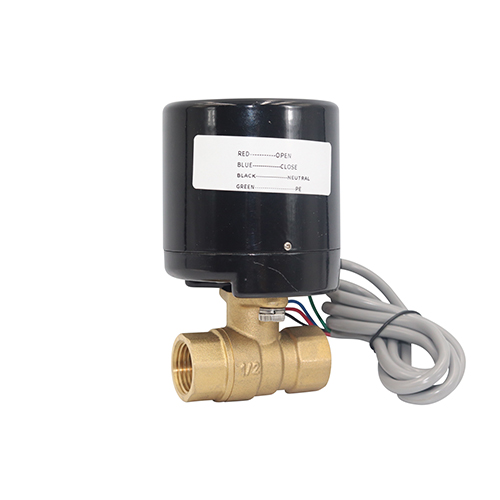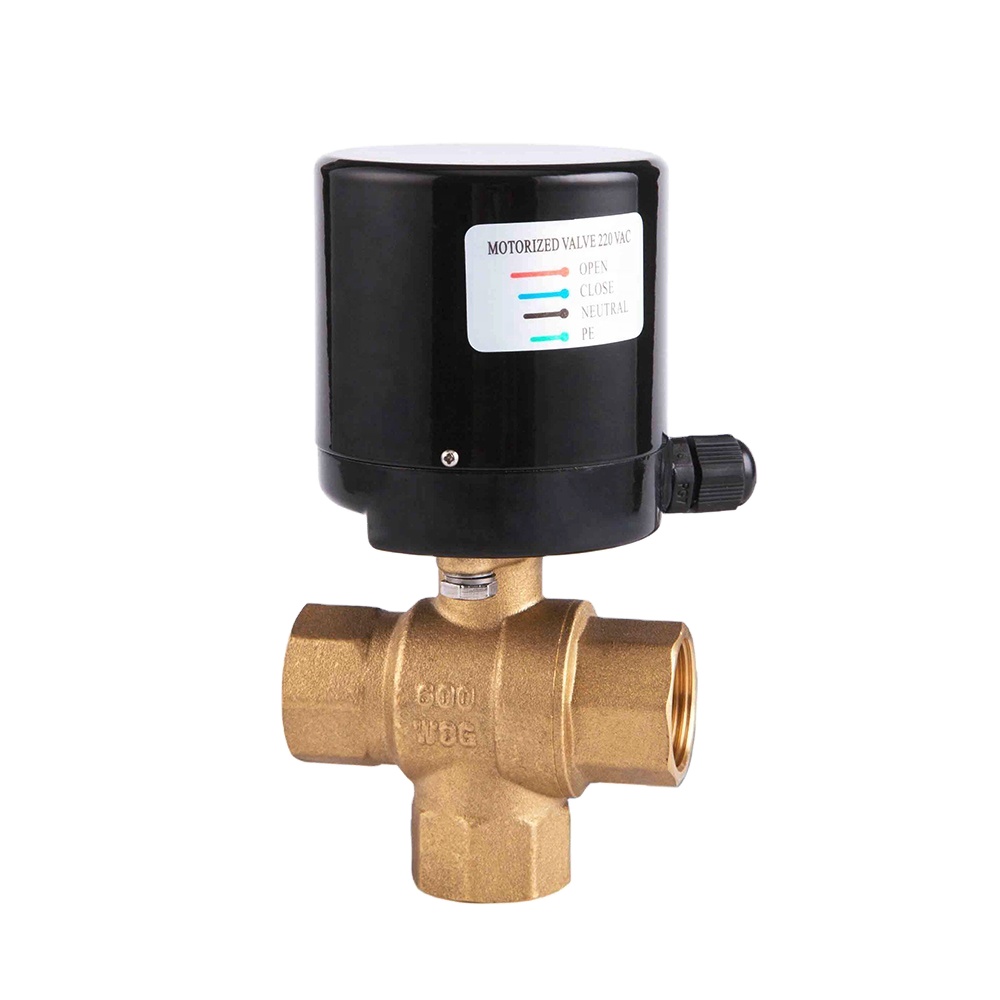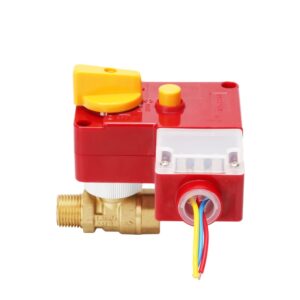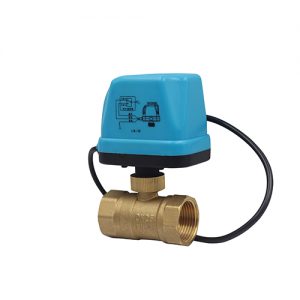Description
Rotary Actuator Mixing Diverting Solenoid Valve
JX-0311
Brass Electric Solenoid Valve
Specification: DN15 — DN25
Model: 2W Series
Material: Brass
Type (Channel Location): Two-way; Three-way
Connection Form: Thread
Applicable medium: Air, Water, and Oil
Flow direction: one-way
Purpose: Influent water
Nominal Path: 10-50mm
Rated voltage: AC220V DC24V DC12V
Working temperature: 80/150 C
Working pressure:0~ 1.0 MPa
Introduction
A Solenoid Valve is an electromechanically operated valve controlled by an electric current running through a solenoid coil. The main operation principle is to use the electromagnetic force provided by the solenoid to operate a plunger or a diaphragm, which, in turn, operates the valve.
When we refer to a”Solenoid Valve Closed Water,” we are specifically talking about a type of solenoid valve designed to control water flow. A “closed” solen” id val”e refers to its default position when not powered or energized. In the case of a normally closed solenoid valve, it will stay closed when no power is applied, preventing water flow. When electrically energized, the valve will open, allowing the flow.
Applications:
Solenoid valves, especially those meant for water control, have various applications:
- Home Appliances: Used in washing machines and dishwashers to control water intake.
- Irrigation Systems: These valves control the water’s distribution in water systems.
- Industrial Applications: Used in various industries to control water flow for cooling, processing, or cleaning purposes.
- Water Treatment Plants: For regulating water flow during various treatment stages.
- Plumbing Systems: Used in commercial buildings to control the water supply in response to specific triggers or sensors.
What Are They Used For?
Solenoid valves are often used for controlling high-pressure steam boiler feedwater systems. They can also be used for fuel metering, air conditioning, pneumatic controls, and hydraulic systems.
A solenoid valve is a type of three-way valve controlling the flow of liquids and gases. It uses an electromagnet to move a plunger inside the valve, which controls the opening and closing of one or both inlets to regulate fluid flow. The plunger is controlled by an electrical current, which causes it to change shape and either block or unblock its corresponding port. They are often used for controlling high-pressure steam boiler feedwater systems.
Applications of a water solenoid valve include regulating the flow of liquids and gases, controlling high-pressure steam boiler feedwater systems, fuel metering, air conditioning, and pneumatic controls.
A solenoid valve uses an electromagnet to change the shape of a plunger inside the valve, controlling the opening and closing of one or both inlets. The plunger is controlled by an electrical current, which either blocks or unblocks the corresponding port. When the current is turned off, the spring inside pushes the plunger back into its original position and closes the port.
Selecting a Solenoid Valve Closed Water:
- Material: Ensure that the valve is made of materials resistant to corrosion, especially for water applications. Common materials include brass or stainless steel.
- Voltage: The solenoid requires an electrical source. Ensure that the voltage requirement of the solenoid matches your supply.
- Pressure Rating: Ensure the valve can handle the water pressure in your system.
- Temperature: If the water’s temperature is expected to vary, the valve water can handle the range without malfunctioning.
- Flow Rate: The valve size and design should match your application’s required flow rate.
In conclusion, an application’s Closed Water is an essential tool in many applications where precise control of water flow is needed. When selecting one, consider its specifications and ensure it matches the requirements of your system. You can ensure efficient and effective water flow control with the right valve.

Types of Water Valves: Variations for Different Purposes
Water valves are an essential part of any water system, and various types are available to meet the specific needs of different applications. Each type of water valve offers unique advantages and can be used in multiple applications, from solenoid valves to ball valves. Here’s a look at the different types of water valves that can achieve various goals.
Solenoid valves are an extremely common type of water valve that uses electromagnets to control a pipeline’s flow rate or direction. These versatile and reliable pipelines come in normally open (NO) and normally closed (NC) configurations, making them ideal for use in many different applications, such as irrigation systems, fuel lines, air conditioners, refrigeration systems, and more.
Key Features and Principles:
- Normally Closed (NC) Design: The default state of the valve is “closed,” meaning that without power, the valve is closed, and no”water flows through it.
- Operation: The valve operates by the action of a solenoid coil. When electricity passes through this coil, a magnetic field is created. This magnetic force pulls a plunger or diaphragm inside the valve, causing the valve to open.
- Response Time: Solenoid valves are known for their rapid response time. This makes them suitable for applications where quick water flow control is necessary.
- Durability: Made for frequent on-off cycles, these valves are designed to be durable and can handle many cycles throughout their lifespan.
Key Takeaways
The solenoid valve closed water system is a reliable and efficient way to ensure that the water supply to your home or business remains safe and secure. This system offers many benefits, including improved safety, increased energy efficiency, reduced maintenance costs, and more. In conclusion, when choosing a water supply solution for your property, the solenoid valve closed water system is an excellent option.
When selecting a solenoid valve closed water system for your property, it’s essential to consider all factors before purchasing. You should assess whether you need single or double valves and examine the size of each and the pressure rating of each part. A backflow preventer may also be necessary if you are looking for extra protection against flooding and other unwanted occurrences.
Actuators Remix is a compact, simple heating controller installed directly onto the mixing and diverting valves. With the function on/off.Compact design, fast installation, ease of use, and reliability.
A solenoid valve is a type of three-way valve that can control the flow of liquids and gases. It uses an electromagnet to move a plunger inside the valve, which controls the opening and closing of one or both inlets to regulate fluid flow. The plunger is controlled by an electrical current, which causes it to change shape and either block or unblock its corresponding port. They are often used for controlling high-pressure steam boiler feedwater systems.

How Do Solenoid Valves Work?
As we mentioned earlier, a solenoid valve is controlled by an electrical current. This current flows through the coil of wire around the plunger inside the valve, which creates a magnetic field. This, in turn, causes the plunger to change shape, unblocking or blocking the corresponding port as required. When the current is turned off, the spring inside the valve pushes the plunger back into its original position and closes the port.
What are the specifications of solenoid valves?
Solenoid valves are vital components in various applications, controlling the flow of liquids and gases in multiple systems. Their specifications are defined based on several parameters to ensure they function correctly and safely. Here are some standard specifications to consider when selecting a solenoid valve:
- Type of Operation:
- Direct Acting: Uses a coil to move the valve plug directly.
- Pilot Operated: Uses line pressure to open and close the valve.
- Semi-Direct Operated: A combination of direct acting and pilot operated.
- The number of Ways and Positions:
- 2-way: One inlet and one outlet.
- 3-way: One inlet and two outlets or two inlets and one outlet.
- 4-way: Commonly used in dual-acting cylinder applications.
- Body Material:
- Materials like brass, stainless steel, PVC, etc., are chosen based on the fluid, application, and environmental conditions.
- Seal Material:
- Examples include NBR (Buna-N), Viton, PTFE, EPDM, and more. The seal material is selected based on compatibility with the fluid being controlled.
- Flow Coefficient (Cv):
- Indicates the valve’s flow capacity, helping select the correct valve size for the required flow rate.
- Operating Pressure:
- Minimum and maximum operating pressure specifications. Ensure the valve is suited for the system’s pressure range.
- Voltage and Power:
- Solenoid valves can be designed for various voltages (e.g., 24V DC, 120V AC, 240V AC). The power consumption (often in watts) is also crucial, especially for continuous duty applications.
- Temperature Rating:
- Both the fluid and ambient temperature ratings are essential. Ensure the valve can handle the temperatures of the environment and the media passing through.
- Response Time:
- How quickly the valve opens or closes once energized.
- Duty Cycle:
- Continuous Duty: The coil remains energized continuously.
- Intermittent Duty: To prevent overheating, the coil is energized for short durations with off periods.
- Connection Type:
- It can be threaded (NPT, BSP), flanged, push-in, compression, and more.
- Enclosure Rating:
- Ratings like IP65 or IP67 indicate protection against dust and water.
- Manual Override:
- Allows the user to manually open or close the valve in case of power failure or maintenance.
- Coil Insulation Class:
- Classifications like Class B, Class F, or Class H indicate the insulation’s ability to withstand temperatures.
- Certifications:
- Depending on the application, certifications like CE, UL, ATEX, etc., might be required.
When selecting a solenoid valve, it’s crucial to understand the specifications of your specific application to ensure safe and optimal operation. Always consult with valve specialists or manufacturers to make an informed decision.
Maintenance Tips
Maintaining a solenoid valve closed water system is essential to keeping it running efficiently and effectively. The system can suffer from dirt buildup and corrosion without proper maintenance, leading to costly repairs. Following these simple but important maintenance tips ensures your solenoid valve closed water system runs smoothly and reliably for years.
To start, regularly inspect the piston seal of the solenoid valve for any signs of wear or damage. Check the inside and outside of the seal for any cracks or tears that could reduce its effectiveness over time. Additionally, clean out all parts of the solenoid valve frequently to remove any dirt buildup that could adversely affect its performance. If necessary, use a specialized cleaning solution specifically designed for this purpose.

How do you produce it and choose a reliable supplier?
Producing a solenoid valve and choosing a reliable supplier involves strategic steps to ensure quality, functionality, and efficient manufacturing processes. Here’s a detailed guide on both aspects:
Producing a Solenoid Valve:
- Design & Prototyping:
- Start with a CAD design based on the desired specifications.
- Prototype the design using 3D printing or small-scale machining for initial testing.
- Material Selection:
- Based on the application, choose the appropriate materials for the valve body, seals, and solenoid coil.
- Machining & Assembly:
- Use CNC machining for the valve body and other components.
- Assemble the solenoid coil, valve body, and other internal components.
- Testing:
- Test the valve under different pressures, temperatures, and flow rates.
- Use the tests to check for leaks, electrical issues, and operational efficiency.
- Quality Control:
- Employ rigorous quality control checks to ensure each valve meets the set standards.
- Implement ISO quality standards for consistent production quality.
- Packaging & Shipping:
- Use protective packaging to avoid damage during transport.
- Ship to distributors, suppliers, or directly to customers.
- After-sales Support: A reliable supplier should offer warranties, return policies, and post-purchase technical support.
- Communication: Effective communication is key. Ensure the supplier is responsive and can address concerns promptly.
- Visit Their Facility: If possible, visit the supplier’s manufacturing facility to observe their processes, machinery, and quality control methods firsthand.
In both production and supplier selection, due diligence is crucial. Invest time in research, evaluation, and direct communication to ensure the solenoid valves are of top quality and the partnership with the supplier is beneficial in the long run.






